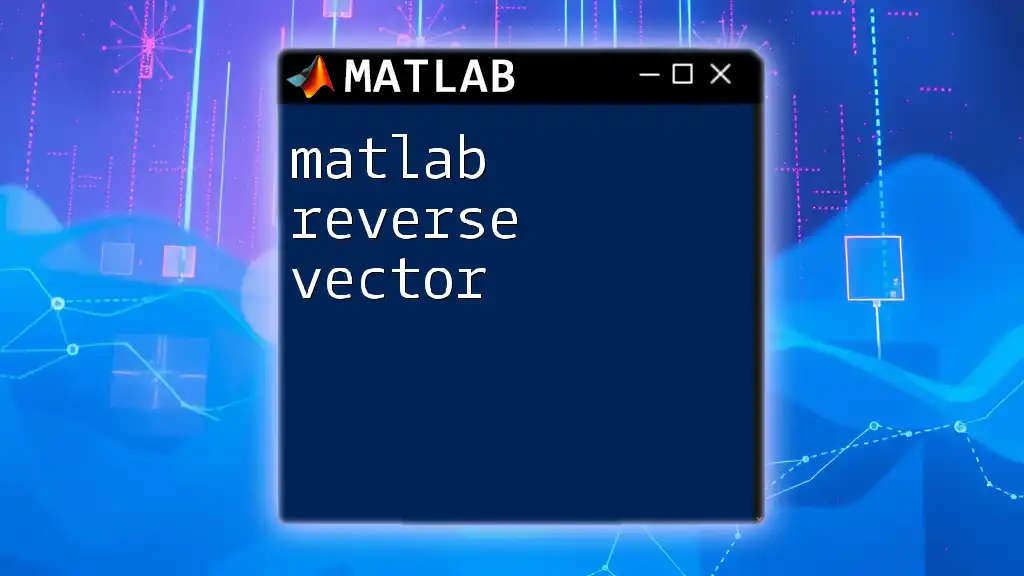The inverse tangent function in MATLAB, denoted as `atan`, computes the angle whose tangent is the given value, returning the result in radians.
% Example of using the inverse tangent function in MATLAB
value = 1; % Input value
angle = atan(value); % Compute the inverse tangent
disp(angle); % Display the result
Understanding the Inverse Tangent
The inverse tangent is a fundamental mathematical function that helps determine the angle whose tangent is a given number. This concept is particularly significant in various fields such as engineering, physics, and computer science, where angles must be calculated from known side lengths.

What is `atan`?
In MATLAB, the function that computes the inverse tangent is called `atan`. This function provides the angle in radians that corresponds to the tangent value passed as its argument. Mathematically, the relation is expressed as:
\[ \theta = \tan^{-1}(x) \]
where `θ` is the angle in radians and `x` is the tangent of that angle.
Syntax of `atan` Function
The basic syntax of the `atan` function in MATLAB is as follows:
result = atan(X)
Here, `X` can be a scalar, vector, or matrix containing the tangent values for which you want to find the angles.

Usage of `atan` in MATLAB
Single Value Input
To find the inverse tangent of a single value, you can use:
angle = atan(1);
Explanation: The output will be `0.7854` radians, which is equivalent to 45 degrees. This output signifies that the tangent of 45 degrees (or π/4 radians) is 1.
Vector and Matrix Input
- Example for Vectors:
angles = atan([1, 0, -1]);
Explanation: Here, the `atan` function is applied to a vector. The output will be a vector of angles, approximately `0.7854`, `0`, and `-0.7854` radians for inputs `1`, `0`, and `-1`, respectively.
- Example for Matrices:
matrix = [1, 2; 3, 4];
angles = atan(matrix);
Output Explanation: The `atan` function will return a matrix of angles corresponding to the tangent values in the original matrix. Each element will contain the angle in radians for the respective tangent value.

Converting Radians to Degrees
Why Convert?
While many calculations in mathematics and engineering naturally involve radians, angles are often more intuitively understood in degrees. Therefore, it is essential to convert radians to degrees when presenting results.
Conversion Method
To convert radians to degrees in MATLAB, you can utilize the `rad2deg` function:
degrees = rad2deg(angle);
Example:
angle_in_degrees = rad2deg(atan(1));
Explanation: The output for this will be `45` degrees, affirming that the inverse tangent of 1 corresponds to 45 degrees.

Practical Examples of `atan` in Applications
Example in Physics
Consider a scenario in physics where we need to calculate the launch angle of a projectile:
- Problem Statement: Suppose we have a projectile that travels a horizontal distance of `10 units` and reaches a vertical height of `5 units`. We want to find the angle of launch.
x = 10; % horizontal distance
y = 5; % vertical distance
angle = atan(y/x);
Explaining the Output: The output will give us an angle of approximately `0.4636` radians, which is about `26.57` degrees. This angle can be crucial for determining the optimal projection in projectile motion.
Example in Robotics
In robotics, the angle of robotic arms must be calculated to achieve desired positions.
- Use Case: If a robotic arm's end effector is at a point `(4, 3)`, we need to compute the angle of the arm relative to the horizontal.
x = 4;
y = 3;
theta = atan(y/x);
Discussion of Real-World Application: This computation yields an angle which can be used to determine the necessary joint parameters of the robot's arm for positioning.

Visualizing the Inverse Tangent Function
To better understand the behavior of the inverse tangent function, you can create a plot in MATLAB that illustrates how the angle changes as the tangent value varies:
x = -10:0.1:10; % Range of x values
y = atan(x);
plot(x, y);
xlabel('x');
ylabel('atan(x)');
title('Inverse Tangent Function');
grid on;
Explanation of the Plot: This visualization demonstrates how `atan` approaches `π/2` as the tangent value increases and `-π/2` as it decreases, reflecting the asymptotic nature of the function.

Common Errors and Troubleshooting
Understanding Edge Cases
While using `atan`, it's essential to understand the constraints of inputs. For instance, providing extremely large or small numbers might not yield intuitive angles due to the nature of the tangent function, which has defined limits.
Debugging Tips
If you run into issues while using `atan`, remember to utilize MATLAB’s built-in help system for guidance. You can easily access this by typing:
help atan
This command provides detailed information about the function, including working examples and input requirements.

Conclusion
In summary, mastering the `atan` function in MATLAB is crucial for anyone dealing with angles in mathematics, engineering, and the sciences. Understanding both its theoretical background and practical applications can significantly enhance your problem-solving capabilities.
Additional Resources
For further learning, explore the official MATLAB documentation on the `atan` function and engage with online forums and communities. These resources can provide additional insights, examples, and support as you elevate your MATLAB skills.

















